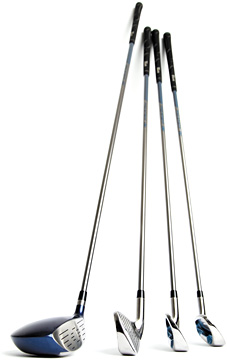To Your Health
February, 2010 (Vol. 04, Issue 02) |
|
|
Other Ways to Reduce Injury Risk: Stretching and Cooldown
Stretching and massage techniques can also help prevent injury. Always warm up before stretching to bring blood flow to the area. The analogy I like to use involves noodles: When you take noodles out of a package, the noodles are stiff and breakable; but place them in boiling water and they become flexible.
A good way to warm up before a round of golf is to take a brisk walk and/or get a quick massage that includes techniques and stretches to increase range of motion. [Chiropractic flexion/extension and other techniques can also increase blood flow and improve range of motion, and many chiropractors now have massage therapists on staff.]
The right way to stretch: If you, as the golfer, prefer to do the warm-up and then stretch, you can begin with three sets of 10-15 deep knee bends [squats] and then walk a quarter of a mile. Next, perform a series of stretches. Reciprocal inhibition stretches, performed by stretching to a level at which your body innately says stop, is effective for increasing range of motion without overstretching and injuring yourself. When you reach the point at which your body says stop, contract the opposite muscle [antagonist muscle] and hold the contraction for several seconds; then release. There should be an increase in of range of motion Now hold the new position for at least 30 seconds, then move on to your next stretch.
 You can also go to the end of the stretch without pulling the muscle, just like reciprocal inhibition, but instead of contracting the opposite muscle, you contract the muscle you are stretching (known as the synergist muscle), hold for several seconds, and then drop down further into the stretch and hold for 30 seconds.
You can also go to the end of the stretch without pulling the muscle, just like reciprocal inhibition, but instead of contracting the opposite muscle, you contract the muscle you are stretching (known as the synergist muscle), hold for several seconds, and then drop down further into the stretch and hold for 30 seconds.
I recommend toe-touch stretches and side stretches. When doing the toe-touch stretch, you must keep a flat back. Do not round your back. When you drop down into the stretch, contract your gluteus maximus and hold the contraction for 6-7 seconds, then breathe and release and you will find yourself falling deeper into the stretch. Note: It is important to never hold your breath even during an Isometric contraction and always feel your breath releasing in and out of your nose, not your mouth. You should also breathe deeply through your diaphragm. The toe-touch stretch will increase flexibility in the hamstrings. Place one arm over you head and bend to the side to do the side stretch. Do this stretch in increments. Example: Go as far as possible without pulling the muscle, then contract the gluteus maximus muscle for several seconds; then release and drop into the stretch, holding for 30 seconds. Repeat 2-3 times on each side.
Cooling down after playing: It is imperative to do some simple breathing and stretching exercises after golfing. Example: Lie flat on your back and tuck your knees to your chest and breathe; hold for 30 seconds. Extend your arm in the supine position [palm up], grab your finger tips and pull your hand down; again, hold for 30 seconds. Next, extend your arm in the prone position (palm down) and grab your fingertips and pull toward you from the bottom position. Hold for 30 seconds. These simple exercises are essential to injury prevention following each round of golf, practice session, etc.
Injuries can happen at any time in any sport, but following these suggestions can certainly help you avoid severe and permanent injuries whenever you're golfing. Always consult your doctor before beginning any exercise program, and check with a golf professional to ensure your swing mechanics aren't putting you at risk for injury. After all, if you're going to golf, why not stay healthy enough to enjoy it?
A Recipe for Disaster
Why are so many golfers are injured every year - 27 million injuries annually, according to some estimates? Here's what Jeff Blanchard, DC, a chiropractor and golf professional who specializes in preventing and treating golf injuries, has to say on the subject: "The average [amateur] has no warm-up or stretching protocols for golf. They are swinging the club with violent, intermittent effort. If ever there were a recipe for injury, this would be it. In addition to intermittent "grip it and rip it" golf swings, many have varied amounts of pre-existing postural dysfunction and poor flexibility. When you add it all up, it's no wonder so many amateur golfers become injured. They are suffering from repetitive strain injuries due to lack of flexibility, postural instability and poor swing mechanics."
Robert Lucarelli, LMT, is a licensed massage therapist and an exercise rehab therapist in Winter Park, Fla.

